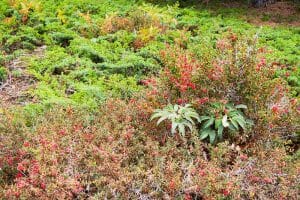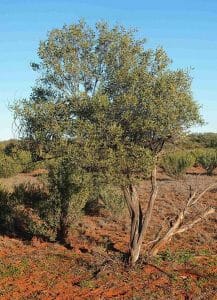Shrub Definition
A shrub is a woody plant that is typically less than 8 meters tall. Unlike a tree, shrubs have several stems and vary widely in size; some shrubs are less than 2 meters high (e.g., rose bushes), while others are around 6 to 8 meters tall (e.g., evergreen hedges such as Leylandii).
Types of Shrubs
Similar to trees, the variation in shrub height is attributed to the environments for which they are adapted and grow. One method of categorizing the different types of shrubs is based on the structural traits, height, and foliage coverage.
Small shrubs
Small shrubs are typically less than 2 meters in height and can be further categorized based on foliage (see photo below).
- Dense Foliage: Small shrubs with dense foliage have between 70% and 100% foliage coverage and are found in closed low shrublands typically characterized by acidic soil and drier climates.
- Mid-Dense Foliage: These are shrubs with only 30% to 70% foliage coverage, and are found in mid-dense low shrublands, such as Hawaii.
- Sparse Foliage: These shrubs are characterized by only 10% to 30% foliage coverage and found in low shrublands.
- Very Sparse Foliage: Shrubs with less than 10% foliage coverage are found in sandy, dry low open shrublands. These shrubs are typically found in desert climates
Mid- to Large-sized shrubs
Mid to large-sized shrubs are typically between 2 and 8 meters in height and similar to small shrubs, can be categorized based on foliage (shown below).
- Dense Foliage: Large shrubs with dense foliage have between 70% and 100% foliage coverage and are called closed shrubs.
- Mid-Dense Foliage: These are shrubs with only 30% to 70% foliage coverage, and are termed open shrubs.
- Sparse Foliage: These shrubs are characterized by only 10% to 30% foliage coverage and found in tall shrublands, such as those found in Australia.
- Very Sparse Foliage: Shrubs with less than 10% foliage coverage are found in tall open shrublands. These shrubs are typically found in desert climates
Quiz
1. Shrubs can be distinguished from trees based on:
A. Height
B. The number of stems
C. Foliage
D. A and B
References
- Bellingham, P. J., and Sparrow, A. D. (2009). Multi-stemmed trees in montane rain forests: their frequency and demography in relation to elevation, soil nutrients and disturbance. J. Ecol. 97, 472–483. doi: 10.1111/j.1365-2745.2009.01479.x
- Bond, W. J., and Midgley, J. J. (2001). Ecology of sprouting in woody plants: the persistence niche. Trends Ecol. Evol. 16, 45–51. doi: 10.1016/S0169-5347(00)02033-4
- Larjavaara, M. (2015). Trees and shrubs differ biomechanically. Trends Ecol. Evol. 30, 499–500. doi: 10.1016/j.tree.2015.07.007
Shrub


No comments:
Post a Comment